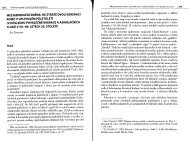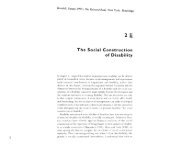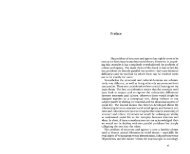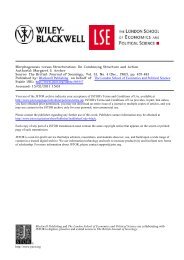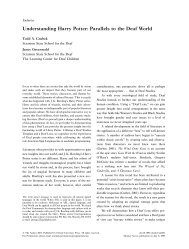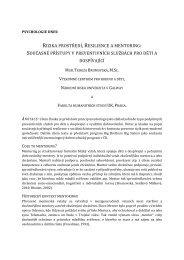Culture and Practical Reason Two Paradigms of ... - Moodle
Culture and Practical Reason Two Paradigms of ... - Moodle
Culture and Practical Reason Two Paradigms of ... - Moodle
- No tags were found...
Create successful ePaper yourself
Turn your PDF publications into a flip-book with our unique Google optimized e-Paper software.
Chapter <strong>Two</strong> 68 <strong>Culture</strong> <strong>and</strong> <strong>Practical</strong> <strong>Reason</strong><strong>Two</strong> <strong>Paradigms</strong> <strong>of</strong> Anthropological Theory69Much <strong>of</strong> Boas' later work, <strong>and</strong> that <strong>of</strong> his students after him can bevi~wed si~ply as the working out <strong>of</strong> implications present in ~hisarticle. [Ibid., p. 159; emphases mine]. In fact, the paths by which Boas reached the cultural concept werediverse <strong>and</strong> sometimes circuitous (cf. Stocking 1968, pp. 195-223; 1974,p~. 1-20). One ~f these is <strong>of</strong> special relevance here, as it developed fromdirect confrontation with Morgan on the issue <strong>of</strong> general laws <strong>of</strong> socialevolution. Modem anthropology tends on balance to consider this particularcontroversy unfortunate, for the nominalist fragmentation operated byBoas on the content <strong>of</strong> cultures to prove the diversity <strong>of</strong> developmentalprocesses .enshrined that "shreds <strong>and</strong> patches" conception <strong>of</strong> the objectthat Amencan ethnology would spend decades in expiating. Indeed, Radinearly <strong>and</strong> vigorously criticized the "quantitative" notion <strong>of</strong> the detached~ulture tra.it ~hich Bo~s had developed out <strong>of</strong> his obsession with disprovmgevolutIOnism (Radm 1966 [1933]). Yet the negative dismemberment <strong>of</strong>culture had to generate a contradictory <strong>and</strong> synthetic result. What hadrationalize~ for Boas the disparity <strong>of</strong> apparently similar traits, as theyactually eXisted .in various societies, were the differences in meanings <strong>and</strong>uses locally assigned. If these meanings implied dissimilar processes <strong>of</strong>development, <strong>and</strong> hence proved Morgan wrong, it was by their implication.also <strong>of</strong> a total <strong>and</strong> oriented context: a culture that patterned the traitsacc~rding to its own unique genius. Since Boas argued that the masks <strong>of</strong>society A, used to deceive the spirits, were not comparable to the masks <strong>of</strong>society B whi~h commemorated the ancestors-<strong>and</strong> similarly that clans,totems, or mOiety systems varied the world over-he had to conclude theexistence <strong>of</strong> cultures: <strong>of</strong> totalities whose "dominant ideas" or patternscreate this differentiation (Boas 1966b [1940], pp. 270-89, <strong>and</strong> passim). Ina well-known article, "History <strong>and</strong> Anthropology," Levi-Strauss observesthe conceptual eventuality <strong>of</strong> the method:Are we then compelled to carry Boasian nominalism to its limit <strong>and</strong>study each <strong>of</strong> the cases observed as so many individual entities? Weshould be.a":are, first, that the/unctions assigned to dual organizationdo not comclde, <strong>and</strong>, second, that the history <strong>of</strong> each social groupdemonstrates that the division into moieties stems from the mostdifferent origins. T~us, ~epending on the case, dual organization maybe ~he result <strong>of</strong> the invaSion <strong>of</strong> a population by an immigrant group; <strong>of</strong>fusion b~tween two neighboring groups, for any <strong>of</strong> several reasons~ec~no~mc, demographic, or ceremonial); <strong>of</strong> the crystallization, inInstltutlOnal form, <strong>of</strong> empirical norms designed to insure marriageexchanges within a given group; <strong>of</strong> the distribution within the group-over two parts <strong>of</strong> the year, two types <strong>of</strong> activity, or two segments <strong>of</strong>the population-<strong>of</strong> two sets <strong>of</strong> antithetical behavior, each <strong>of</strong> which isconsidered equally indispensable for the maintenance <strong>of</strong> social equilibrium;<strong>and</strong> so forth. We are therefore forced to reject the concept <strong>of</strong>dual organization as a spurious category <strong>and</strong>, if we extend this line <strong>of</strong>reasoning to all other aspects <strong>of</strong> social life, to reject institutions exclusively,in favor <strong>of</strong> societies. [Levi-Strauss I963b , pp. 10-11]Boas's general problematic thus differs radically from Morgan's. WhereMorgan had understood practice <strong>and</strong> its customary formulation by the logic<strong>of</strong> objective circumstances, Boas interpolated an independent subjectivebetween the objective conditions <strong>and</strong> organized behavior, such that thelatter does not follow mechanically from the former. On the psychologicallevel, where it was first announced, the intervening term may be characterizedroughly as a mental operation, generated by context <strong>and</strong> previousexperience, which in governing the perception specifies the relation betweenstimulus <strong>and</strong> response (fig. 7). On the cultural level, toward whichBoas's thought was in continuous development, the mediating term is thetradition, the Volkergedanken or the dominant pattern, which orders atonce the relation to nature, the existing institutions, <strong>and</strong> their interaction(fig. 8).The similarity <strong>of</strong> both formulas to Levi-Strauss's is unmistakable(above, pp. 56-57). Indeed the terms <strong>of</strong> Levi-Strauss's statement <strong>of</strong> hisposition-in opposition to a certain Marxism-perfectly describe Boas aswell, even to the specification <strong>of</strong> the tertium quid between praxis <strong>and</strong>practices as a "conceptual scheme" (or code). Adopting these terms, thetheoretical contrast between Boas <strong>and</strong> Morgan might be generally set out asshown in figure 9.Of course "conceptual scheme" has a different quality in these twoperspectives. For Boas it is the encoding, while for Morgan it is thecodification, <strong>of</strong> distinctions external to itself. For Boas the significance <strong>of</strong>the object is the property <strong>of</strong> thought, whereas for Morgan thought is therepresentation <strong>of</strong> objective significance. If in Morgan's conception, then,thought <strong>and</strong> language function as sign, Boas's is essentially a problematic<strong>of</strong> the symbolic. Indeed the structure <strong>of</strong> the symbolic as Boas developed itwould account for empiricist-rationalist views <strong>of</strong> the kind Morgan entertained:that is, as a characteristic form <strong>of</strong> cultural self-reflection, a postfactumappeal to the reasonableness <strong>of</strong> practices whose true logic is inexplicit<strong>and</strong> whose true sources are unknown.



